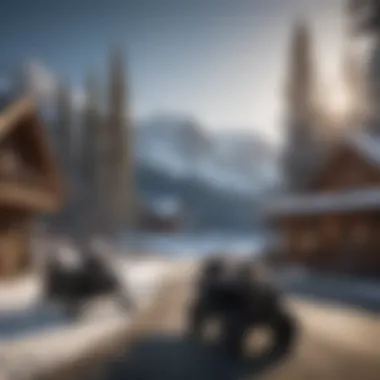Top Snowmobiling Destinations in Montana


Intro
Montana is a land of diverse landscapes, attracting a multitude of outdoor enthusiasts. Among these activities, snowmobiling holds a prominent position, providing adrenaline and adventure against a backdrop of snow-capped mountains and pristine wilderness. Understanding the characteristics of top snowmobiling locations can greatly enhance the experience for both novice and seasoned riders. This article aims to detail key destinations in Montana and their unique features that cater to snowmobiling.
The significance of selecting the right snowmobiling spot lies not only in the thrill of the ride but also in encountering the breathtaking scenic views and understanding local regulations. Each site presents its own advantages related to trail difficulty, accessibility, amenities, and environmental surroundings, shaping the overall adventure. Moreover, a well-informed snowmobiler is a safer and more responsible one. Understanding these components leads to more enjoyable and meaningful rides.
This guide will delve into specific locations within Montana, analyzing relevant aspects that facilitate informed decisions for your snowmobiling journey. Excitement awaits as we explore how Montana's landscapes foster the perfect environment for winter adventures.
Prologue to Snowmobiling in Montana
Snowmobiling in Montana is more than just an adrenaline-filled activity. It is a way to explore the state’s dramatic landscapes. These include vast forests, rolling hills, and majestic mountain ranges. For many, it offers a temporary escape from daily life and a chance to connect with nature. In this segment, we will delve into the significance of snowmobiling in the region and explore the regulatory framework that governs this thrilling sport.
Significance of Snowmobiling in the Region
Snowmobiling plays a crucial role in Montana's winter culture. It not only provides recreational opportunities but also bolsters the local economy. Towns near popular trails benefit from increased tourism. Shops, hotels, and restaurants see enhanced business during the snowmobiling season.
Moreover, it serves as a social activity for families and friends. Many riders create lasting memories while navigating snowy terrain. Montana’s rich biodiversity and scenic vistas enhance the experience further. The free access to vast, open spaces adds to the draw, making it popular among both locals and visitors.
Regulatory Framework
Engaging in snowmobiling in Montana requires understanding specific regulations. Each area has guidelines regarding where to ride, what equipment to use, and the necessary permits. Knowing such details ensures safety and compliance with state laws.
Montana has designated snowmobile trails that are maintained for public use. Riders must obtain a snowmobile registration from the state. This registration is crucial for legality while traversing public lands. Additionally, it is essential to follow local speed limits and areas that are off-limits to protect wildlife and promote sustainability. Through these regulations, Montana aims to balance recreation with environmental stewardship.
Top Snowmobiling Areas in Montana
Montana's vast expanse includes numerous areas ideal for snowmobiling. These locations not only provide thrilling rides, but they also offer unique scenery and access to the extrodinary wilderness. Assessing these snowmobiling areas helps riders find suitable trails matching their skill levels and interests. Understanding specific attributes of these destinations facilitates informed decisions for safe and enjoyable experiences.
Bitterroot National Forest
Trail Overview
Bitterroot National Forest features a number of trails that appeal to all levels of snowmobilers. The trails are well-maintained and range from beginner to advanced, making it a versatile choice. A key feature of the Bitterroot trails is their length, allowing for longer rides that can lead to deeper experiences in nature. The trails wind through stunning landscapes, offering glimpses of mountain peaks and forests. However, some trails may be challenging due to steep inclines, so proper preparation is essential.
Access Points
Access points in Bitterroot National Forest are conveniently located. Most are easily reachable from major highways, enabling quick transport to the trails. Designated parking areas are marked, ensuring riders can start their adventure without hassle. Highlighting these access points adds an element of ease for both novice and experienced riders alike. Nonetheless, riders should regard possible seasonal road closures that might limit accessibility during certain periods.
Amenities Available
Bitterroot National Forest provides several amenities for snowmobilers. Local services include fueling stations and repair shops, which are critical for long outings. Additionally, nearby lodging options offer places to stay after a day’s adventure. However, amenities can vary in availability, particularly during peak season, so careful planning is advisable.
Gallatin National Forest
Popular Trails


Gallatin National Forest is renowned for its diverse and popular trails, making it an excellent snowmobiling destination. Trails here often attract visitors for their varied terrains, from open meadows to winding paths through dense trees. One unique feature is the snowmobiling trails that connect with backcountry skiing routes; this makes it appealing for different enthusiasts. The possibility of high traffic on popular trails can sometimes detract from the experience, so early starts are recommended.
Scenic Features
The scenic features of Gallatin National Forest stand out among snowmobiling locations. Mountains provide dramatic backdrops to the trails. The forests are lush with conifer trees that create beautiful views. These features contribute to a memorable experience, illustrating the beauty of Montana's wilderness. However, riders should stay aware of changing weather conditions that might affect visibility and trail conditions.
Wildlife Encounters
Wildlife encounters are a compelling aspect of snowmobiling in Gallatin National Forest. Riders often spot animals like deer and elk, enhancing the experience while highlighting the intricate relationships between these animals and their environment. However, it is crucial to follow safety guidelines and maintain a respectful distance from wildlife. Riders must prioritize safety and ethics in their natural encounters.
Flathead National Forest
Trail Systems
The trail systems in Flathead National Forest are extensive, catering to a wide range of skill levels. The network of trails features connecting paths, allowing riders to create personalized loops based on their preferences. A key characteristic of the system is the marked trails indicating challenge levels, which simplifies the experience for less experienced riders. Nevertheless, riders should stay informed about trail signs that can help prevent navigational issues.
Access Considerations
Access considerations for Flathead National Forest are integral to planning a snowmobiling trip. Multiple points of entry are available, each with signage for easy navigation. Some popular areas can become crowded, so timing is important to avoid peak conditions. Riders should be aware of possible parking limitations near entry points during busy weekends.
Suggested Routes
Suggested routes in Flathead National Forest provide guidance for both amateurs and pros. Various maps are available outlining trails, showcasing noteworthy sights along the way. This assistance is beneficial for first-time visitors who may not be familiar with the terrain. However, adhering to suggested routes can limit exploration and experiences; so some discretion is important for seasoned riders.
Helena-Lewis and Clark National Forest
Trail Analysis
Trail analysis in Helena-Lewis and Clark National Forest reveals a landscape rich in variety. Trails vary not only by difficulty but also by environment, from dense forests to open plains. This diversity allows riders to choose based on their preferences. Some trails have rugged sections that require technical skill, which may pose challenges for inexperienced riders. Understanding trail conditions before heading out is essential for safety.
Facilities and Services
This national forest offers a range of facilities and services to cater to snowmobilers. There are information centers that provide maps, current trail conditions, and safety guidance. Also, visitors can find rest areas along popular routes, promoting comfort during extended trips. However, some areas may lack sufficient services during the winter, so riders should come prepared with provisions.
Difficulty Levels
The difficulty levels of trails in Helena-Lewis and Clark National Forest are varied. They cater to both beginners looking for gentle slopes and advanced riders who seek thrilling challenges. The mix of trail grades creates opportunities for families to sled together, with options for all skill levels. Riders should always consider their own skill levels relative to trail ratings when planning their excursions.
Pioneer Mountains
Terrain and Conditions
Navigating the Pioneer Mountains presents both rewards and challenges due to their distinct terrain. This area features high elevations that can lead to variable snow conditions, impacting trail use and safety. Riders can expect an exhilarating experience, but they must also prepare for rapid shifts in weather, which can affect visibility and trail safety. Knowing the terrain is crucial to avoid potential hazards.
Recommended Locations
Recommended locations within the Pioneer Mountains provide strategic starting points for snowmobilers. Each spot has particular features, such as access to popular trails or stunning views. This assists riders in finding their ideal adventure based on interests. Some locations may not have signage or guidance, meaning riders should either carry a map or have knowledge of the area.


Safety Guidelines
Safety guidelines are essential in the Pioneer Mountains due to the region's unpredictable nature. Riders should wear safety gear and remain within marked trails to minimize risks. Furthermore, understanding avalanche conditions can be vital in this territory. Local resources can often help provide updates on current risks, enhancing rider safety significantly.
Understanding the varying features of these noted areas prepares riders for their snowmobiling endeavors across Montana. Each destination contributes unique elements that make snowmobiling an engaging and enjoyable sport.
Trail Conditions and Their Impact
Trail conditions significantly influence the overall experience of snowmobiling in Montana. These conditions affect not only the safety and enjoyment of riders but also the environmental footprint of the sport. Analyzing trail conditions helps snowmobilers choose appropriate gear, plan their routes effectively, and ensure they are prepared for challenges. The state’s vast and varied landscapes necessitate a close examination of trail conditions, which can shift due to seasonal changes, weather patterns, and maintenance efforts. Understanding these factors can elevate the snowmobiling experience, ensuring both enjoyment and adherence to safety measures.
Seasonal Variations
Seasonal variations play a crucial role in determining the quality of snowmobiling trails in Montana. The state experiences distinct seasons, each bringing unique weather elements that can alter trail surfaces. In winter, fresh snowfall provides ideal conditions for snowmobiling. However, early or late in the season, trails might be uneven or packed down.
Some important aspects of seasonal variations include:
- Snow Quality: Fresh powder offers superior conditions compared to hard-packed or icy surfaces. It enhances grip and control for riders.
- Temperature Fluctuations: Rising temperatures can lead to melting, resulting in muddy or slushy conditions that may be hazardous for snowmobilers.
- Trail Accessibility: Certain trails might become unavailable due to snowmelt or obstructions like fallen trees. Regular updates from local authorities can inform riders about accessibility.
Trail Grooming and Maintenance
Trail grooming and maintenance are essential for preserving the quality of snowmobile trails. Grooming operations smooth out uneven surfaces, making for a safer and more enjoyable ride. Maintenance includes various activities such as removing debris, addressing rough spots, and marking trails.
Some considerations regarding trail grooming and maintenance include:
- Grooming Schedules: Different areas may have different grooming schedules. Riders should check local grooming reports, often provided by organizations like the Montana Snowmobile Association.
- Impact on Environment: Responsible grooming practices are crucial. Excessive grooming might disrupt wildlife habitats or alter the landscape unnecessarily.
- Rider Awareness: It is important for riders to respect grooming zones and stay off freshly groomed surfaces when possible. Doing so allows trails to set properly and enhances overall safety.
In summary, trail grooming plays a vital role in maintaining optimal snowmobiling conditions, benefitting both riders and the environment.
Safety Considerations for Snowmobiling
Safety is a fundamental aspect of snowmobiling. Without proper attention to safety, the thrill of exploring Montana's snow-covered landscapes can turn dangerous. Safety considerations encompass various elements, including proper gear, navigation skills, and being aware of environmental factors. Understanding and implementing these safety protocols enhance the overall experience. Riders not only protect themselves but also respect the terrain and wildlife of Montana.
Essential Gear and Equipment
When preparing for a snowmobiling trip, the right gear and equipment are non-negotiable. Essential items include:
- Helmet: A durable helmet is vital for protecting against head injuries. Opt for one that meets safety standards.
- Goggles: These should be anti-fog and scratch-resistant to ensure clear vision.
- Layered Clothing: Dress in layers to manage body heat effectively. Thermal undergarments, insulated jackets, and waterproof outer layers work well.
- Gloves and Boots: Insulated gloves and waterproof boots provide warmth and dryness.
- First Aid Kit: Always have a first aid kit on hand in case of accidents.
- Emergency Supplies: Items like a flashlight, whistle, and a survival blanket can be lifesaving in unforeseen situations.
Using appropriate gear not only enhances comfort but also significantly increases rider safety.
Navigation Skills
Navigation is critical in snowmobiling. It ensures you remain on the correct path and allows you to avoid hazardous areas.
Compasses and GPS
A compass is a basic yet effective navigation tool. It allows riders to determine their direction reliably. While GPS devices provide real-time location data and maps, they can be affected by signal loss in remote areas. Thus, knowing how to use both is beneficial.


Key characteristic:
- Reliability: Compasses do not rely on batteries and function in a variety of conditions.
- Real-time Data: GPS provides current locations and may offer trail specifics, which is advantageous when exploring new areas.
Each has its advantages. Compasses offer simplicity and dependability, while GPS provides detailed location info. However, snowmobilers must know how to navigate without relying solely on technology.
Trail Maps
Trail maps outline specific routes and terrain details, contributing significantly to trip planning. They are usually produced by local snowmobile clubs or forestry services.
Key characteristic:
- Route Planning: Maps help identify trails, steep areas, and rest stops along the way.
- Hazard Awareness: Many maps indicate marked routes to avoid risky or environmentally sensitive regions.
Trail maps allow for careful planning and decision-making. However, they can become outdated, so carrying up-to-date versions is essential. Understand and interpret maps for a smoother adventure and safer navigation.
Proper gear, navigation skills, and awareness of the terrain are key components of staying safe while snowmobiling in Montana. Not only does it protect the rider, but it also fosters appreciation for the beautiful yet fragile environment.
Environmental Considerations
Snowmobiling in Montana provides an excellent blend of recreation and a unique way to experience the state's pristine landscape. However, it's essential to consider environmental factors associated with this activity. This section discusses how snowmobiling impacts wildlife and outlines sustainable practices that can be adopted to protect the ecosystem during such excursions.
Impact on Wildlife
The expansive wilderness areas in Montana, particularly those frequented by snowmobilers, are home to diverse wildlife. Snowmobiling can disturb these animals, particularly in sensitive habitats. For instance, during winter, many species depend on energy reserves to survive the harsh conditions. If snowmobiles encroach on their habitats, it can lead to stress, reduced feeding opportunities, and disrupted migration patterns.
To minimize these impacts, snowmobilers should be conscious of the trails they choose. Areas known for wildlife activity should be avoided whenever possible. Additionally, certain regions may have seasonal restrictions to protect vulnerable species. By following posted guidelines, riders not only preserve wildlife but also contribute to a balanced ecosystem.
Sustainable Practices
Adopting sustainable practices is vital for the longevity of snowmobiling opportunities in Montana. Here are some key measures snowmobilers can implement to ensure minimal environmental impact:
- Stay on Designated Trails: This practice prevents damage to delicate vegetation and reduces the risk of soil erosion.
- Respect Seasonal Closures: Abiding by seasonal restrictions helps safeguard wildlife during critical periods, such as breeding seasons.
- Choose Environmentally Friendly Equipment: Modern snowmobiles are designed to be more fuel-efficient and produce fewer emissions. Opting for such machines contributes to reducing the carbon footprint of snowmobiling activities.
- Educate Fellow Riders: Sharing knowledge about environmental considerations can foster a culture of responsibility among the snowmobiling community.
"Conservation begins with awareness. Each snowmobiler can play a part in protecting the wilderness they cherish."
Sustainable practices promote not just environmental protection, but also enhance the overall experience. Riders will likely find their excursions more enjoyable when they know they are playing a part in preserving Montana's natural beauty.
Ending
The conclusion of this article summarizes the critical aspects discussed regarding snowmobiling in Montana. Understanding the unique attributes, accessibility, and environmental impacts of these snowmobiling spots is essential for both enjoyment and responsible usage. The evaluation of each location allows snowmobilers to make informed choices that enhance the overall experience.
Key Takeaways
In analyzing the various snowmobiling destinations in Montana, several key points emerge:
- Diversity of Terrain: Montana offers a wide range of trail systems from easy to challenging, catering to different skill levels.
- Environmental Awareness: Riders must be mindful of wildlife and natural habitats, ensuring that their activities do not disrupt local ecosystems.
- Regulatory Compliance: Familiarity with local laws and regulations is vital to ensure a safe and enjoyable experience while avoiding legal issues.
- Preparation is Key: Having the right gear and equipment can significantly improve safety and comfort on the trails.
Future of Snowmobiling in Montana
Looking ahead, the future of snowmobiling in Montana seems promising. As technology advances, snowmobiles become more efficient and eco-friendly. Moreover, the growing interest in winter sports may spark enhancements in trail maintenance and the introduction of new routes. However, maintaining a balance between recreation and conservation will be paramount. Engaging with local communities and stakeholders can spearhead initiatives that promote sustainable practices.
As winter sports continue to evolve, Montana’s vast landscapes promise to remain a cherished destination for snowmobiling enthusiasts. The combination of natural beauty and thrilling experiences will keep attracting riders. However, it will be crucial to prioritize sustainability to preserve these trails for generations to come.







